Korean Art for Touring
Part of 1 Learning Collection
Sultana's Dream - short story by Rokeya Sakhawat Hossain / visual adaptation by Chitra Ganesh
<p>Chitra Ganesh' Takeaway</p>
<p>Chitra Ganesh' Takeaway</p>
PAST - AAS 208 / HISTART 208: Introduction to African Art: 100 African Objects
<p>Featuring object labels written by students in t...
<p>Featuring object labels written by students in t...
Created For
K-12 EducatorK-12 Student
Museum Visitor
UMMA Docent
UMMA Staff
University Faculty
University Student
Rate this Resource
AVG: 0 | Ratings: 0
& Author Notes
Creative Commons by-nc-saLast Updated
February 27, 2021 9:02 p.m.Report
Reporting Policy

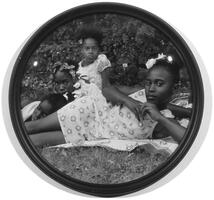
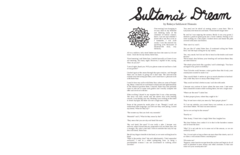
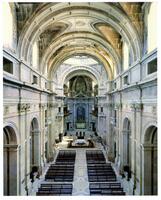
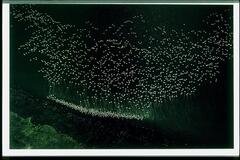
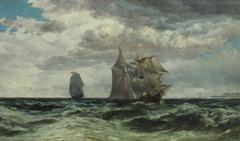

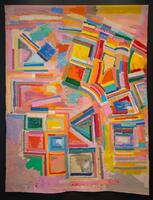
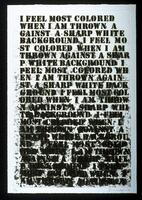
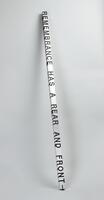
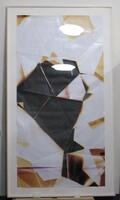

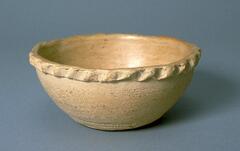



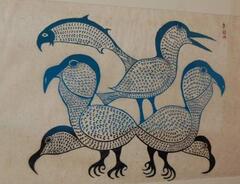
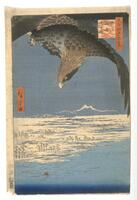
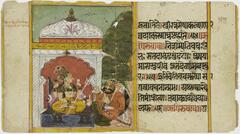
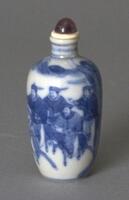
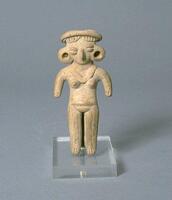
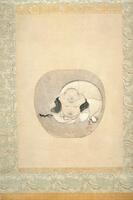
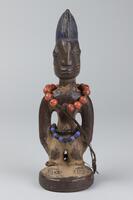
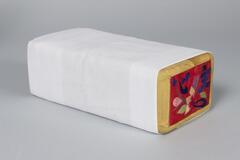
![A glazed porcelain jar, whose body is wide and round with a lipped, wide opening. Detailed with a Korean character, possibly a label for the jar's contents, in blue.<br />
<br />
Both sides of the shoulder are decorated with letters that resemble Japanese hiragana syllables. The vessel appears to have been produced under the influence of Japanese technology and capital. The entire vessel is glazed except the foot rim. The high kaolin content of the clay has produced a light jar with thin walls.<br />
[Korean Collection, University of Michigan Museum of Art (2014) p.208] A glazed porcelain jar, whose body is wide and round with a lipped, wide opening. Detailed with a Korean character, possibly a label for the jar's contents, in blue.<br />
<br />
Both sides of the shoulder are decorated with letters that resemble Japanese hiragana syllables. The vessel appears to have been produced under the influence of Japanese technology and capital. The entire vessel is glazed except the foot rim. The high kaolin content of the clay has produced a light jar with thin walls.<br />
[Korean Collection, University of Michigan Museum of Art (2014) p.208]](/media/W1siZiIsIjIwMjIvMDkvMjQvam83amRsZXQwX2RlZmF1bHQuanBnIl0sWyJwIiwidGh1bWIiLCIyNDB4MjAwIl1d?sha=5b175c254d3221e9)
![A ceramic rounded bowl with a tall, trapered cylindrical stand with a wide lip. The base is detailed with staggered square cut-outs that run from the lip to the middle of the base.<br />
<br />
This is a dark-gray, single-tiered, perforated, high-fired stoneware stem cup. The body of the cup curves upwards, and the rim has a sharp edge, while the inner surface of the mouth is tapered. A deep incised line divides the pedestal into its upper and lower halves; the lower half features square perforations. A natural glaze is pooled at the base of the cup, while the bottom of the outer surface shows traces of rotation and water smoothing.
<p>[Korean Collection, University of Michigan Museum of Art (2017) p. 65]</p>
A ceramic rounded bowl with a tall, trapered cylindrical stand with a wide lip. The base is detailed with staggered square cut-outs that run from the lip to the middle of the base.<br />
<br />
This is a dark-gray, single-tiered, perforated, high-fired stoneware stem cup. The body of the cup curves upwards, and the rim has a sharp edge, while the inner surface of the mouth is tapered. A deep incised line divides the pedestal into its upper and lower halves; the lower half features square perforations. A natural glaze is pooled at the base of the cup, while the bottom of the outer surface shows traces of rotation and water smoothing.
<p>[Korean Collection, University of Michigan Museum of Art (2017) p. 65]</p>](/media/W1siZiIsIjIwMjIvMDkvMjQvNDJsMWV4ZDdsMF9kZWZhdWx0LmpwZyJdLFsicCIsInRodW1iIiwiMjQweDIwMCJdXQ?sha=cc501fe9e527e365)
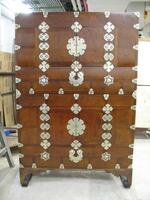
![A bundle of thin fibres (which form the brush) held together by thin strips of wood wrapped around one half of the bundle, topped with a piece of cloth to create a cap.<br />
<br />
This brush was used in a procedure called bemaegi , which involves starching fabric to level threads on the surface of the warp and maintain humidity. It was made of pine roots and by binding them together at the end of the handle with hemp cloth.
<p>[Korean Collection, University of Michigan Museum of Art (2017) p. 279]</p>
A bundle of thin fibres (which form the brush) held together by thin strips of wood wrapped around one half of the bundle, topped with a piece of cloth to create a cap.<br />
<br />
This brush was used in a procedure called bemaegi , which involves starching fabric to level threads on the surface of the warp and maintain humidity. It was made of pine roots and by binding them together at the end of the handle with hemp cloth.
<p>[Korean Collection, University of Michigan Museum of Art (2017) p. 279]</p>](/media/W1siZiIsIjIwMjIvMDkvMjQvOHdjZ3d1azVrdF9kZWZhdWx0LmpwZyJdLFsicCIsInRodW1iIiwiMjQweDIwMCJdXQ?sha=88d372e313e26601)
![This rice bowl, or <em>jubal</em>, has a flat base. Normally, such rice bowls are classified into three different sizes: large, medium-sized and small. Their shapes are almost identical.<br />
<p>[Korean Collection, University of Michigan Museum of Art (2017) p. 250]</p>
This rice bowl, or <em>jubal</em>, has a flat base. Normally, such rice bowls are classified into three different sizes: large, medium-sized and small. Their shapes are almost identical.<br />
<p>[Korean Collection, University of Michigan Museum of Art (2017) p. 250]</p>](/media/W1siZiIsIjIwMjIvMDkvMjQvNGd1ZWVranRqeV9kZWZhdWx0LmpwZyJdLFsicCIsInRodW1iIiwiMjQweDIwMCJdXQ?sha=543e203bee500732)
![A tall glazed and speckled porcelain offering dish for an altar. The base is a narrow and sharply tapered cylinder which meets an angular bottom of a dish. The dish itself is wide and shallow.<br />
<br />
This vessel built from low quality clay and is coated with a blue-green-tinted glaze, giving it a pale green-brown tone overall. Coarse sand is stuck to the foot rim. The tray is contaminated by many impurities and iron spots. The vessel was produced at a regional kiln.<br />
[Korean Collection, University of Michigan Museum of Art (2014) p.199] A tall glazed and speckled porcelain offering dish for an altar. The base is a narrow and sharply tapered cylinder which meets an angular bottom of a dish. The dish itself is wide and shallow.<br />
<br />
This vessel built from low quality clay and is coated with a blue-green-tinted glaze, giving it a pale green-brown tone overall. Coarse sand is stuck to the foot rim. The tray is contaminated by many impurities and iron spots. The vessel was produced at a regional kiln.<br />
[Korean Collection, University of Michigan Museum of Art (2014) p.199]](/media/W1siZiIsIjIwMjIvMDkvMjQvMWhjOGxzaG1pYV9kZWZhdWx0LmpwZyJdLFsicCIsInRodW1iIiwiMjQweDIwMCJdXQ?sha=4e7af2c94d8e11b8)
![It is a urinal earthware. There is a everted mouth on the round body. It is unglazed.<br />
<br />
This is a gray, turtle-shaped, low-fired earthenware bottle. The neck is attached to one end of the body, rising outwards before flaring out once again. Its rim is round. The inner surface of the neck and the lower part of the body show signs of rotation and water smoothing. The bottom of the bottle is rounded.
<p>[Korean Collection, University of Michigan Museum of Art (2017) p. 77]</p>
It is a urinal earthware. There is a everted mouth on the round body. It is unglazed.<br />
<br />
This is a gray, turtle-shaped, low-fired earthenware bottle. The neck is attached to one end of the body, rising outwards before flaring out once again. Its rim is round. The inner surface of the neck and the lower part of the body show signs of rotation and water smoothing. The bottom of the bottle is rounded.
<p>[Korean Collection, University of Michigan Museum of Art (2017) p. 77]</p>](/media/W1siZiIsIjIwMjIvMDUvMjUvNHk4ZzA3OXR2X2RlZmF1bHQuanBnIl0sWyJwIiwidGh1bWIiLCIyNDB4MjAwIl1d?sha=311e0038afc07cc8)
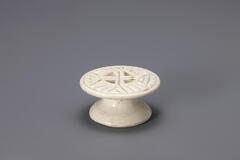
![It is simple in shape, like a donut but with a sharply trimmed rim in the manner of a metal vessel. The hole in the middle is believed to be a symbol of Eastern philosophy. Designs are painted on the surface in cobalt blue pigment.<br />
<br />
This ring-shaped water dropper is decorated with a figures-in-landscape design on its upper surface and a floral scroll design on its sides rendered in cobalt blue. A line runs around the foot and sand was used as kiln spurs. The clay and glaze are well fused. This is one of many water droppers that were produced at Bunwon-ri, Gwangju-si, Gyeonggi-do, in the late 19th century.<br />
[Korean Collection, University of Michigan Museum of Art (2014) p.183] It is simple in shape, like a donut but with a sharply trimmed rim in the manner of a metal vessel. The hole in the middle is believed to be a symbol of Eastern philosophy. Designs are painted on the surface in cobalt blue pigment.<br />
<br />
This ring-shaped water dropper is decorated with a figures-in-landscape design on its upper surface and a floral scroll design on its sides rendered in cobalt blue. A line runs around the foot and sand was used as kiln spurs. The clay and glaze are well fused. This is one of many water droppers that were produced at Bunwon-ri, Gwangju-si, Gyeonggi-do, in the late 19th century.<br />
[Korean Collection, University of Michigan Museum of Art (2014) p.183]](/media/W1siZiIsIjIwMjIvMDUvMjUvOTBoZmdzcDIzOV9kZWZhdWx0LmpwZyJdLFsicCIsInRodW1iIiwiMjQweDIwMCJdXQ?sha=fd361ef6e2403ab9)
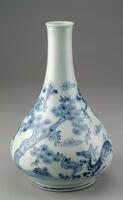
![This jar has a long and upright mouth with a robust shoulder that give way to a body tapering toward the base. The crane, cloud, pine tree and rock are painted with blue and red copper pigment.<br />
<br />
This jar was produced at a kiln in Bunwon-ri, Gwangju-si, Gyeonggi-do after the privatization of official court kilns in 1883. Ten longevity symbols, including pine trees, rocks, lingzhi fungus, deer, cranes, clouds and bamboo, are decorated in cobalt-blue and copper-oxide pigment was used in parts to decorate the jar. Such jars featuring the ten longevity symbols were often used at events such as elder statesmen’s gathering (giroyeon) and 60th birthday parties (hoegabyeon). Crackles were formed on the mouth and body, which are contaminated with impurities, but it remains intact overall. The foot retains traces of coarse sand supports, but lots of cracks were formed.<br />
[Korean Collection, University of Michigan Museum of Art (2014) p.169] This jar has a long and upright mouth with a robust shoulder that give way to a body tapering toward the base. The crane, cloud, pine tree and rock are painted with blue and red copper pigment.<br />
<br />
This jar was produced at a kiln in Bunwon-ri, Gwangju-si, Gyeonggi-do after the privatization of official court kilns in 1883. Ten longevity symbols, including pine trees, rocks, lingzhi fungus, deer, cranes, clouds and bamboo, are decorated in cobalt-blue and copper-oxide pigment was used in parts to decorate the jar. Such jars featuring the ten longevity symbols were often used at events such as elder statesmen’s gathering (giroyeon) and 60th birthday parties (hoegabyeon). Crackles were formed on the mouth and body, which are contaminated with impurities, but it remains intact overall. The foot retains traces of coarse sand supports, but lots of cracks were formed.<br />
[Korean Collection, University of Michigan Museum of Art (2014) p.169]](/media/W1siZiIsIjIwMjIvMDUvMjUvNjdqd3QzZzEybV9kZWZhdWx0LmpwZyJdLFsicCIsInRodW1iIiwiMjQweDIwMCJdXQ?sha=fecc2783f3328016)
